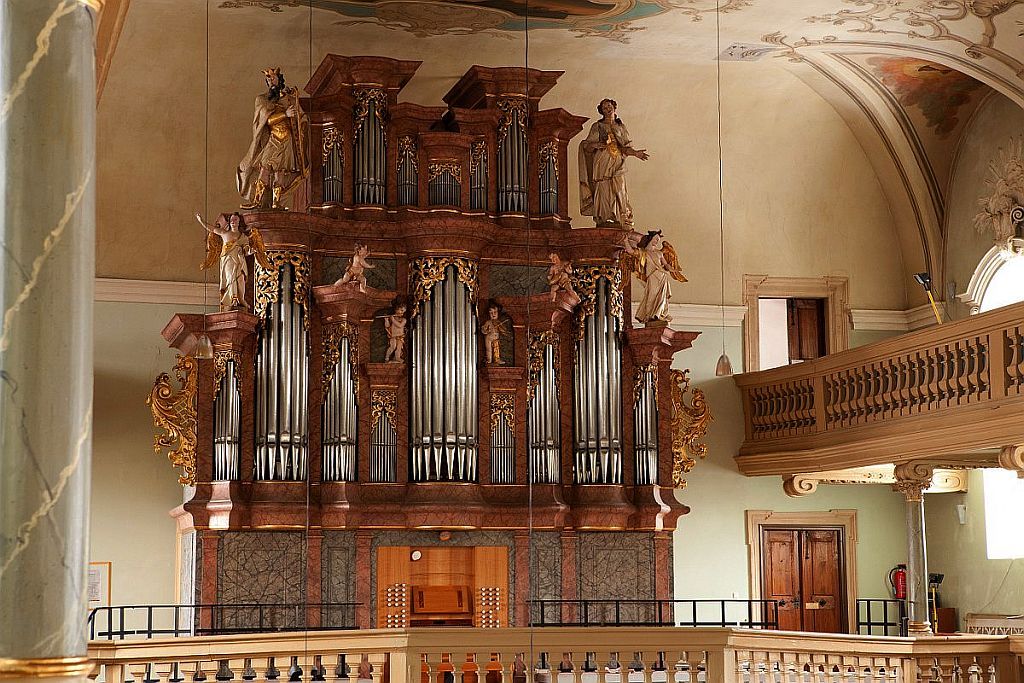Ausführliche Beschreibung der vorgewählten Orgel

Bild: René Troost
Erlangen, Deutschland (Bayern) - Neustädter Kirche (Universitätskirche)
Gemeinde: Erlangen
Region:Mittelfranken
Adresse: Neustädter Kirchenplatz, 91054, Erlangen
Website: http://www.erlangen-evangelisch.de/Neustadt/
Beschreibung nr.: 2008442.
Gebaut von: Friedrich Goll Orgelbau AG (2005)
Die Orgel enthält älteren Material: aus 1741 von Johann Gils, Pipes aus 1910/1919 von G.F. Steinmeyer und Co.
Technische Daten
Disposition
Hauptwerk (C-g'''): Bourdon 16' - C-B from Subbass, Principal 8' - front 1741, Human Gedackt 8' - 1919, Viola da Gamba 8', Doppelflöte 8' - 1910, Octava 4', Spitzflöte 4', Quinta 2 2/3', Super Octava 2', Terz 1 3/5', Cornet 5 fach (from g°), Mixtura 4 fach (1 1/3'), Fagott 16', Trompete 8'.
Oberwerk (C-g'''): Rohrflöte 8', Quintatön 8', Salicional 8', Principal 4' - front 1741, Klein Gedackt 4', Viola 4', Nasat 2 2/3', Flageolet 2', Terz 1 3/5', Mixtur 4 fach (2'), Krummhorn 8', Vox Humana 8', Tremulant.
Schwellwerk (C-g'''): Violon 16', Cor de Nuit 8', Tibia 8' - 1919, Gambe 8', Voix Célèste 8' (from c°), Prestant 4', Flûte Octaviante 4', Octavin 2', Plein Jeu 2-5 fach (2'), Trompette Harmonique 8', Hautbois 8', Clairon 4', Tremulant.
Pedal (C-f'): Untersatz 32' - 1919; C-B acoustic, Violon Bass 16' - 1919, Sub Bass 16' - 1919, Principal Bass 8', Violoncello 8' - transmission, Gedackt 8' - transmission, Bassetto 4', Posaunen Bass 16', Fagott 16' - transmission, Trompeten Bass 8'.
Koppeln: Hauptwerk - Oberwerk, Hauptwerk - Schwellwerk, Oberwerk - Schwellwerk, Pedal - Hauptwerk, Pedal - Oberwerk, Pedal - Schwellwerk.
Nebenregister und Spielhilfen: Electronische Setzer.

Bild: René Troost
Erlangen, Deutschland (Bayern) - Neustädter Kirche (Universitätskirche)
Gemeinde: Erlangen
Region:Mittelfranken
Adresse: Neustädter Kirchenplatz, 91054, Erlangen
Website: http://www.erlangen-evangelisch.de/Neustadt/
Beschreibung nr.: 2008442.
Gebaut von: Friedrich Goll Orgelbau AG (2005)
Die Orgel enthält älteren Material: aus 1741 von Johann Gils, Pipes aus 1910/1919 von G.F. Steinmeyer und Co.
| Jahr | Orgelbauer | Opus | Aktivität | 1741 | Johann Gils | Neubau | 1857 | E.F. Walcker & Cie. | 149 | Umbau | 1896 | G.F. Steinmeyer und Co. | Änders der Disposition | 1911 | G.F. Steinmeyer und Co. | Verschiedene Tätigkeiten | 1919 | G.F. Steinmeyer und Co. | 1277 | Neubau im alten Gehäuse | 1936 | G.F. Steinmeyer und Co. | Vergrößerung | 2005 | Friedrich Goll Orgelbau AG | Neubau im alten Gehäuse |
- On August 28, 1741, a new organ was built in the Neustädter Kirche in Erlangen, built by Johann Gils. It was a large organ with 31 stops, divided over two manuals and pedal. The front was decorated with beautiful carvings by Elias Räntz. The organ has been converted several times, including a complete rebuild by Walcker in 1855-1857 and modifcations by Steinmeyer in 1896 and 1911. In 1919 Steinmeyer built a new organ in the old case, using much old pipe work. In 1936 Steinmeyer enlarged the instrument with a Rückpositiv and some baroque registers were added, in the spirit of the Orgelbewegung.
- The whole instrument was not only artistically unsatisfying, but the mechanics and action soon became unreliable. In 2000 it was finally decided to have a new organ built in the old case, using the still existing Gils pipework (mainly the front pipes). The company Goll was commissioned in 2002. Pipework by Steinmeyer from 1919 has also been reused.
- The new organ was dedicated on October 2, 2005. Advisor Christoph Reinhold Morath played the organ during church service. In the afternoon two concerts followed by Ekkehard Wildt and Konrad Klek.
Technische Daten
| Anzahl Register pro Manual | |
| - Hauptwerk | 14 |
| - Oberwerk | 12 |
| - Schwellwerk | 12 |
| - Pedal | 10 (7) |
| Gesamtzahl der Stimmen | 48 (45) |
| Tastentraktur | Mechanical |
| Registertraktur | Electrical |
| Windlade(n) | Slider chests |
Disposition
Hauptwerk (C-g'''): Bourdon 16' - C-B from Subbass, Principal 8' - front 1741, Human Gedackt 8' - 1919, Viola da Gamba 8', Doppelflöte 8' - 1910, Octava 4', Spitzflöte 4', Quinta 2 2/3', Super Octava 2', Terz 1 3/5', Cornet 5 fach (from g°), Mixtura 4 fach (1 1/3'), Fagott 16', Trompete 8'.
Oberwerk (C-g'''): Rohrflöte 8', Quintatön 8', Salicional 8', Principal 4' - front 1741, Klein Gedackt 4', Viola 4', Nasat 2 2/3', Flageolet 2', Terz 1 3/5', Mixtur 4 fach (2'), Krummhorn 8', Vox Humana 8', Tremulant.
Schwellwerk (C-g'''): Violon 16', Cor de Nuit 8', Tibia 8' - 1919, Gambe 8', Voix Célèste 8' (from c°), Prestant 4', Flûte Octaviante 4', Octavin 2', Plein Jeu 2-5 fach (2'), Trompette Harmonique 8', Hautbois 8', Clairon 4', Tremulant.
Pedal (C-f'): Untersatz 32' - 1919; C-B acoustic, Violon Bass 16' - 1919, Sub Bass 16' - 1919, Principal Bass 8', Violoncello 8' - transmission, Gedackt 8' - transmission, Bassetto 4', Posaunen Bass 16', Fagott 16' - transmission, Trompeten Bass 8'.
Koppeln: Hauptwerk - Oberwerk, Hauptwerk - Schwellwerk, Oberwerk - Schwellwerk, Pedal - Hauptwerk, Pedal - Oberwerk, Pedal - Schwellwerk.
Nebenregister und Spielhilfen: Electronische Setzer.
| Übrige dispositiondaten | |
|---|---|
| Mehrere dispositionen |
|
| Literatur |
Organ 2/2003. |
| Aufnahmen |
Die Kunst der Orgelimprovisation : Die vier Jahreszeiten : Vol. 6 / Markus Willinger. - ORGANpromotion OP 4006 (CD). - 2007. |
| Weblinks |
https://www.goll-orgel.ch/work/neubau/erlangen-neustadter-universitats-kirche/ |
 |
 |
 |
 |
 |
 |
